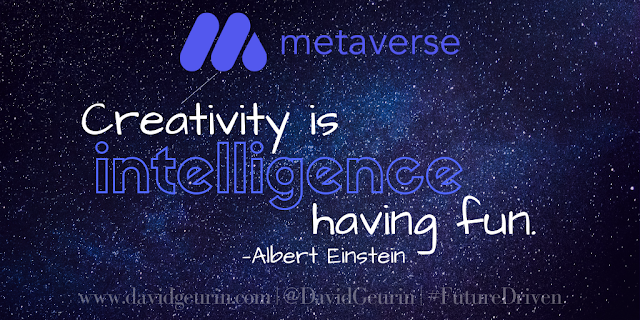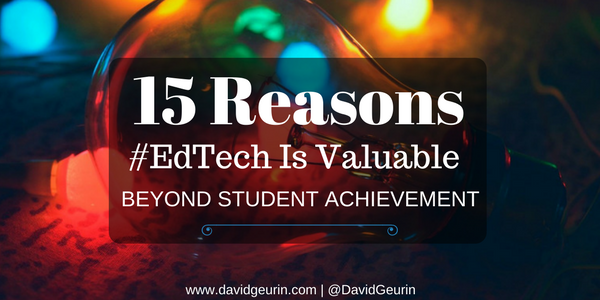Developing a shared vision for technology in your school should include lots of conversations. These conversations should occur among teachers, students, parents, and other stakeholders. It's important to think through the pros and cons of technology use and how technology can play an valuable role in learning.
Sometimes I think people hold ideas about technology that only consider one side of the issue. Forward thinking educators and parents want to race ahead with technology implementation without considering some of the drawbacks.
On the other hand, status quo defenders quickly point out the drawbacks of technology use in the classroom without considering how important technology will be to student success in a rapidly changing world.
To bridge the divide, we need to have more honest conversations and seek to understand the various issues. Whichever way we lean, we need to consider various perspectives and use good thinking to arrive at common ground.
Here are 5 conversations to have about education technology in your classroom or school.
1. Why is technology use important?
Even if you don't really like the prominent role of technology in our society, it is indisputable that more and more opportunities are tied to the effective use of technology for learning and productivity. In our modern world, digital technology is how stuff gets done. And clearly the internet is not going away. And mobile technology is not just a fad.
So if we are going to truly prepare students for their future, we must include technology as an essential part of the learning process. Technology needs to be implemented in authentic ways that reflect the way it is used by people across a wide variety of professions.
We should also invite students to use their imaginations to consider how technology might be used in the future. Opportunities for innovation abound. The ability to adapt and create might allow students to 'create' a job for themselves even when the traditional way of 'finding' a job might prove more difficult. All the rules are changing.
2. What are things technology won't do for your classroom or school?
Technology should not be viewed as something that will automatically result in better learning for students. In fact, technology can actually hurt learning if it is not implemented properly. It's important to start with a strong learning culture and a teacher who inspires and guides learning. Effective technology use requires effective leadership.
So let's talk openly about the limitations of technology.
- Adding technology won't make a poor lesson suddenly great.
- It won't fix a learning culture that is sluggish or disengaged.
- It won't necessarily result in higher standardized test scores.
- Technology isn't appropriate for every learning task.
- Technology can be a distraction.
- It can also bring new concerns for student wellness and safety.
3. How can we overcome challenges that come with technology use?
Too many educators focus on the drawbacks or challenges to technology use and never even consider how these obstacles can be overcome. There are significant challenges when using technology for learning. However, there are plenty of schools that are doing a great job of addressing and overcoming every one of the challenges. But it takes a concerted effort to address these concerns.
- Educators must model safe and appropriate use of technology.
- Schools must teach digital citizenship and activate students as digital leaders.
- Schools must support professional learning for teachers on technology use.
- Effective pedagogy must be prioritized over using technology for the sake of technology.
- Schools must develop strong relationships with students, parents, etc. so that there is a cooperative effort to make technology work for learning.
4. What are the most valuable ways we can use technology for learning?
Not all uses of technology are created equal. Some ways of using technology are more valuable than others. We need to use technology in ways that are high leverage for learning.
When used effectively, technology can be powerful. In fact, it can transform learning. In an earlier post I listed 7 Ways Technology Transforms Learning. Most importantly, technology can empower learning. It can give learners greater voice, more opportunities, and provide the platform to create new knowledge in a very personal and customized way.
Some ways of using technology are not as effective for learning. They don't result in greater student agency, deeper thinking, or more opportunities to connect with others.
- Drill and kill on a device is still low leverage.
- Activities that are simply "busy work" are still mindless even on a device.
- Test prep programs are not my idea of authentic technology use.
- Worksheets are not more engaging just because they are pushed out on a device.
Effective learning with technology should involve students in making decisions about their learning. There should be opportunities for students to make learning choices about time, place, path, or pace.
5. How are you growing in your use of technology as an educator?
One of the most important parts of successful use of technology in schools is that educators are growing in their use of technology, too. It's critical for leaders to model learning with digital tools. In fact, anyone who wants to be a leader needs to be a digital leader, too. It's not something reserved for the technology department or techie teachers only. Everyone needs to model learning in this area.
I think some teachers still think technology is reserved for students who are going into IT or some other computer related field. But that's just not the case. Nearly every profession will be impacted by technology advances. Moreover, every person needs skills for how to use technology for learning and creating. It's not about knowing specific tech tools. It's about knowing how to be an effective learner in a modern digital world. Using the tools just flows from the needs of being a learner.
Everyone is at a different place on their personal learning journey. Educators should understand and embrace this. Not every teacher has to be at a certain level. But the point is to continuously grow. Keep learning and taking risks with technology. Always.
Question: How are these technology conversations going for you? What other conversations should educators be having related to technology? I want to hear from you. Leave a comment below or respond on Twitter or Facebook.



















